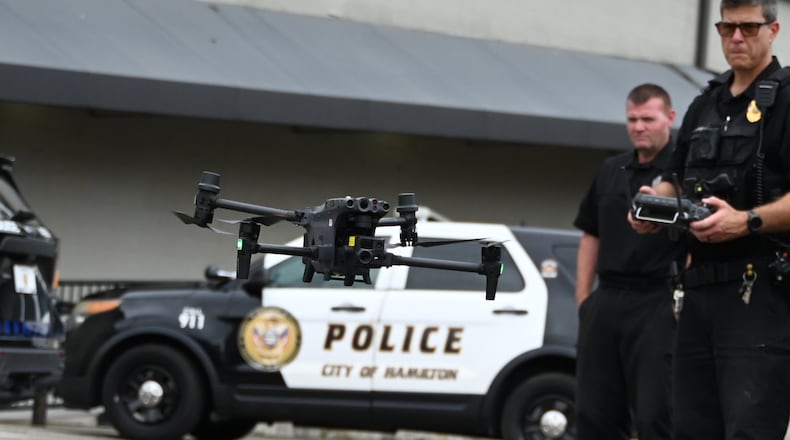Hamilton police had a drone assigned to be used for its SWAT team several years ago and was the last Butler County police department to acquire a drone for patrol work when it purchased a DJI Matrice M30T.
Sgt. Matt Fishwick said it’s beginning to change the way the police approach various scenarios because maybe they don’t have to go on a high-speed chase, which was the case earlier this year when officers caught a suspect wanted in a car theft ring.
“We used it to maintain surveillance and eyes on a car thief suspect,” he said of the case where a couple was charged with stealing 10 cars from dealers in Hamilton. “We were able to follow them until they got out of the vehicle, so we didn’t have to worry about getting into a chase.”
Trenton Police Department Sgt. Craig Flick said his department’s drone program has been “wildly successful.” Similar to Hamilton, they’ve been able to capture suspects and locate missing juveniles and adults, like Alzheimer’s patients. They’ll fly the drone at events, and conduct traffic studies or aid the fire department with structure fires.
It’s improved policing, he said, as “it gives us another view.”
“It provides a real-time look into what would be a blind situation,” Flick said. “The technology has allowed us to do things in the idea of public safety.”
The American Civil Liberties Union released a report in July 2023 about the speed at which police departments are acquiring drones. At the time of the report, there were more than 1,400 police departments using drones.
“A world where flying robotic police cameras constantly crisscross our skies is one we have never seen before,” according to the report authored by Jay Stanley, ACLU senior policy analyst. “Yet there are strong reasons to believe that such a world may be coming faster than most people realize.”
The report concluded that drones “often elicit a visceral response” when the purpose of their presence isn’t clear and “they are inscrutable and often perceived as alien and hostile.”
Flick said police agencies “have zero interest” in knowing who’s in a person’s backyard, and they’re not looking into windows.
“It’s essentially another tool available to us for emergency situations,” he said. “The technology allows us to do things that we’ve never been able to do before in the idea of public safety.”
The evolution of tools used by police officers is constant, from the analog pieces of equipment like handguns and Tasers, to the specialized training of K-9 units. Drones are no different than in-car cameras and body cameras, and with video evidence, for many ― from attorneys to judges to juries ― “seeing is believing.”
“In the world today, if it’s not on video, a lot of time people have a hard time believing that it happens,” said Fairfield Police Chief Steve Maynard. “Or if they don’t see something on video, it’s hard for them to understand what took place. They want that video evidence.”
And as technology plays a major role in everyone’s lives today, Maynard said police work is no different.
“The tools that we have, technology-wise, certainly increase our capacity to conduct our criminal investigations and conduct our day-to-day operations,” he said. “To stay up with the times, it’s certainly important for law enforcement to stay up to speed on the technological advances.”
With many departments using drones, departments are coordinating local training, both to maximize the use of drones and to prepare for possible collaboration if a large-scale police issue arises.
Maynard said this training helps identify which departments have which types of drones, though many have a Matrice M30T, a brand product of DJI, a standard-bearer of the technology. Drones have their limitations, including anyone piloting must be certified through the FAA. Then there is the cost. Most have one large one, like the Matrice M30T, which costs anywhere from $7,000 to more than $10,000 depending on what features are on the camera and other accessories, like the necessary extra batteries and rotor blades.
They are also limited with battery life and how much area can be covered as the drone operator must keep the device in sight.
“We have trained together and work together, and there’s also technology out there that will allow us to share the live feeds from the drones,” Maynard said. “The drone provides us with a view that we would not have. Essentially it’s the proverbial eye in the sky.”
While drones are the latest tool for police to help solve crimes, find missing persons and keep the public safe, Flick said departments will find ways to integrate technology as it advances, and to work in concert with current and older tools, such as K-9 officers.
“Where before we had a K-9 officer trained to do a specific thing, with a specific purpose, and now we can supplement that with our technology, with our drones to only enhance operations and to only make things more efficient.”
About the Author


